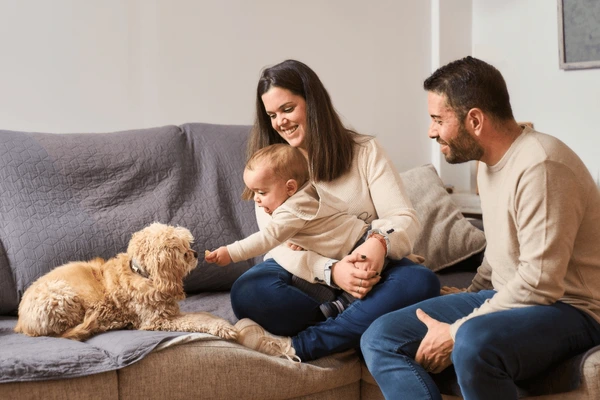For many families, pets are an inseparable part of daily life. They occupy our sofas, follow our footsteps, and hold a quiet place in our hearts. Yet, when pregnancy enters the picture, questions and fears suddenly surface. Many expectant parents hear conflicting advice: avoid the cat, keep the dog away, pets will weaken the baby’s immunity, and so on.
These beliefs, often passed down for generations, do not reflect what modern science tells us. In fact, evidence consistently shows that pets can coexist safely and beautifully with both pregnant women and young children and even contribute positively to their health and emotional development.
This article brings a clear, science-based view to help families navigate pregnancy, newborn life, and early childhood while keeping the beloved family pet right where it belongs: at home.
Pets and Pregnancy: What the Evidence Shows
The presence of pets in the home does not increase pregnancy complications. Major medical organizations, including the CDC, ACOG, and AAP, do not recommend removing a pet when a woman becomes pregnant. Dogs, cats, rabbits, and other household pets are generally safe companions throughout pregnancy. In fact, several studies highlight benefits: living with pets may reduce maternal stress by decreasing cortisol levels, promoting emotional well-being, and improving daily mood. Pregnancy is an emotionally intense period, and a familiar pet’s presence often brings stability and comfort.
The only notable concern is toxoplasmosis, a parasitic infection sometimes associated with cats. It is important to emphasize that toxoplasmosis is linked to handling contaminated cat litter, not touching, petting, or living with a cat. Indoor cats who do not hunt and do not eat raw meat rarely carry it. Precaution is simple: pregnant women should avoid cleaning litter boxes or use gloves and wash hands afterward. With these simple steps, the risk becomes extremely low and there is no medical reason to rehome a cat.
How Pets Shape a Baby’s Immune System
One of the most common fears is that pets might trigger allergies, asthma, or infections in young children. However, large-scale studies, such as the PARSIFAL and GABRIEL birth cohorts, consistently show that early-life exposure to pets can reduce the risk of allergic diseases. This protective effect is linked to how early microbial exposure supports immune system maturation. Babies who grow up around animals encounter a wider variety of harmless environmental microbes, which helps train their immune system, reducing the likelihood of exaggerated allergic responses later on.
Of course, hygiene remains important. Washing hands after pet contact, keeping vaccinations up to date, and maintaining clean feeding areas are practical, normal steps that every family should follow.
Introducing a Newborn to a Home With Pets
Newborns and pets can coexist safely when interactions are supervised. Pets are naturally curious, and the arrival of a baby introduces new routines, smells, and sounds. Families should maintain the pet’s usual schedule as much as possible to avoid stress and behavioral changes.
Before the baby arrives, parents can help their pet adjust by:
- Allowing them to explore baby items and nursery smells
- Playing recorded baby sounds to desensitize them
- Rewarding calm curiosity
Once the newborn is home, supervision during interactions is essential, not because pets are inherently dangerous, but because babies are unpredictable and pets can become excited. Basic rules: no face licking, no access to the baby unsupervised, and consistent boundaries and ensure a peaceful transition.
Many pets develop gentle, protective behavior around infants, becoming an invaluable source of comfort as the child grows.
The Emotional and Developmental Benefits for Children
Beyond physical health, pets offer profound emotional and developmental advantages throughout childhood. Multiple studies in child psychology show that children who grow up with animals tend to demonstrate:
- Enhanced empathy and emotional intelligence
- Better social skills
- Reduced stress and anxiety
- Improved responsibility and self-confidence
- Stronger emotional regulation during difficult moments
A pet often becomes a child’s first companion, teaching kindness, patience, and nurturing in ways that screens or toys never could. These daily lessons shape healthier emotional development and secure attachment patterns.
Teaching Children Respect and Boundaries
While pets enrich childhood, children also need guidance to interact safely and respectfully. Parents should model and teach:
- Gentle touch and appropriate handling
- Not disturbing pets while they eat or sleep
- Understanding signs of discomfort in animals
- Giving pets personal space when needed
This mutual respect protects both the child and the pet and nurtures a healthy, joyful relationship.
Pets Are Family and Please Not Seasonal Gifts
A critical point, especially around the holiday season, is the misconception of giving pets as surprise gifts. A pet is a long-term commitment requiring time, care, and emotional involvement. Sadly, many animals are abandoned after holidays when families realize they were unprepared. If a family is ready to welcome a pet, the decision should be thoughtful and intentional. And whenever possible, adoption from shelters is a compassionate choice.
What Happens If My Child Is Allergic to Our Pet?
Sometimes parents discover that their child may be reacting to a pet: sneezing, itchy eyes, or mild breathing symptoms. This can be stressful, and many families immediately fear they will have to give the pet away. In most cases, this is not necessary. The first step is simply confirming the allergy with a specialist, because symptoms can sometimes come from dust, pollen, or other triggers.
If the child is truly allergic to the pet, there are many gentle, practical steps that can help without breaking the bond with the animal. Simple changes: keeping the pet out of the child’s bedroom, using an air purifier, washing hands after play, cleaning fabrics more often, and giving the pet regular grooming can make a big difference. Most families find that with these adjustments and the occasional use of antihistamines if recommended by their doctor, their child stays comfortable while still enjoying the love and companionship of the pet.
Rehoming a pet should only be the last option, and only in rare cases where the child has strong symptoms that do not improve despite every effort. For the majority of children, allergies can be managed safely and kindly allowing the family to stay together and the child to continue growing up with the emotional comfort a pet brings.
Conclusion
Pregnancy, newborn life, and early childhood can all unfold safely and joyfully alongside family pets. Far from being a risk, pets often play a protective role in a child’s development. Research shows that early exposure to pets actually reduces the risk of allergies and asthma, thanks to the way early-life microbes help the immune system mature in a healthier, more balanced way.
With simple hygiene, supervision, and a few practical adjustments when needed, pets become part of the child’s learning, emotional growth, and everyday comfort. They help children build empathy, responsibility, self-regulation, and resilience and qualities that stay with them for life. Families do not need to separate from their pets when a new baby arrives. They simply need clear information, gentle guidance, and confidence in what science already supports. A home filled with children and pets is not a danger, it is a nurturing environment where immunity is strengthened, emotional bonds grow deeply, and childhood becomes richer, calmer, and more connected.












